Explaining the Law of Demand and Supply
VerifiedAdded on 2023/01/11
|15
|3275
|40
AI Summary
This document explains the law of demand and supply, movement along the same demand curve, changes in demand curve, and factors affecting the demand curve. It also discusses the law of supply, movement along the same supply curve, changes in supply curve, and factors affecting the supply curve. The document compares and contrasts emerging theories and models in 21st-century contemporary economics with those of the 20th century and relates them to modern business practices.
Contribute Materials
Your contribution can guide someone’s learning journey. Share your
documents today.
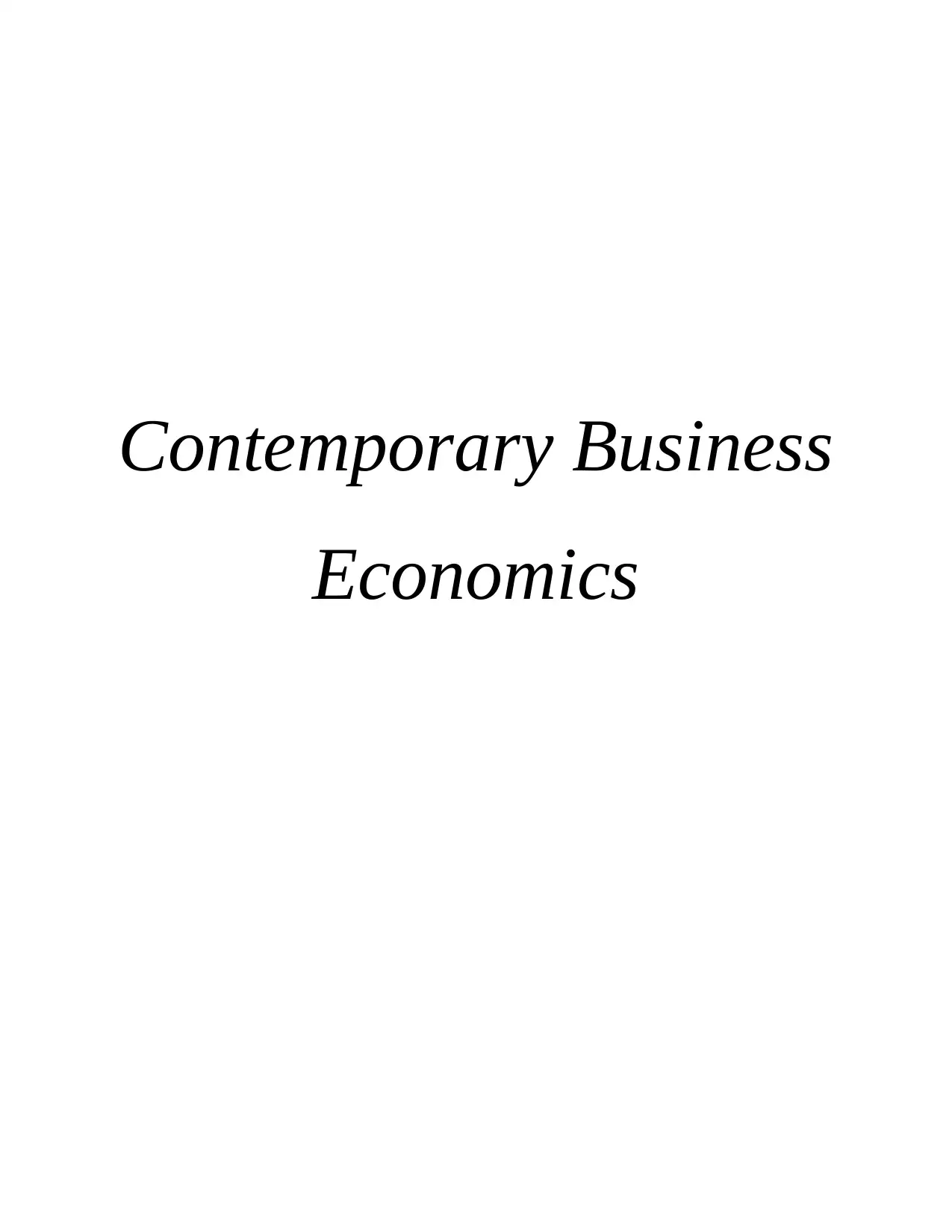
Contemporary Business
Economics
Economics
Secure Best Marks with AI Grader
Need help grading? Try our AI Grader for instant feedback on your assignments.
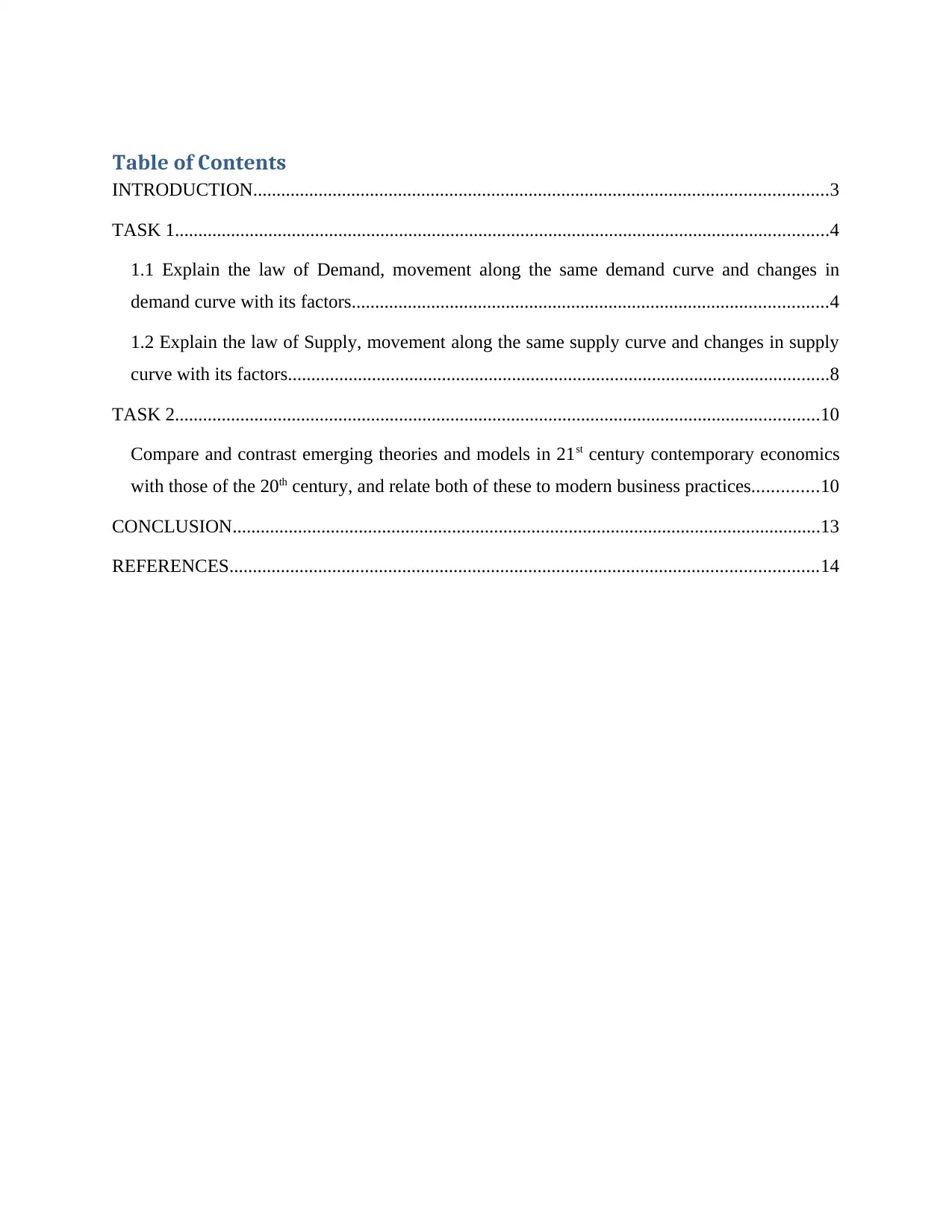
Table of Contents
INTRODUCTION...........................................................................................................................3
TASK 1............................................................................................................................................4
1.1 Explain the law of Demand, movement along the same demand curve and changes in
demand curve with its factors......................................................................................................4
1.2 Explain the law of Supply, movement along the same supply curve and changes in supply
curve with its factors....................................................................................................................8
TASK 2..........................................................................................................................................10
Compare and contrast emerging theories and models in 21st century contemporary economics
with those of the 20th century, and relate both of these to modern business practices..............10
CONCLUSION..............................................................................................................................13
REFERENCES..............................................................................................................................14
INTRODUCTION...........................................................................................................................3
TASK 1............................................................................................................................................4
1.1 Explain the law of Demand, movement along the same demand curve and changes in
demand curve with its factors......................................................................................................4
1.2 Explain the law of Supply, movement along the same supply curve and changes in supply
curve with its factors....................................................................................................................8
TASK 2..........................................................................................................................................10
Compare and contrast emerging theories and models in 21st century contemporary economics
with those of the 20th century, and relate both of these to modern business practices..............10
CONCLUSION..............................................................................................................................13
REFERENCES..............................................................................................................................14

INTRODUCTION
The word 'micro' is derived from the Greek word 'micros' which means short. Thus micro is
related to small units. In individual economics, economic activities of different small units of an
economy are analyzed. In other words, under individual economics, special individuals, families,
firms, industries, special workers, etc. are analyzed. For example, how does a consumer balance
his income and expenditure. How does a producer manage the production in his factory, how is
the price of a single item like wheat or ghee fixed etc. There are many economic problems that
are studied in individual economics.
This project report consists of two tasks; 1 and 2. In first task; concept of law of demand and
supply has been explained with reference to the Wal-Mart retail business; with the help of
diagram. In task 2; theories of both contemporary in 21st and 20th century has been compared and
related with modern business practices.
The word 'micro' is derived from the Greek word 'micros' which means short. Thus micro is
related to small units. In individual economics, economic activities of different small units of an
economy are analyzed. In other words, under individual economics, special individuals, families,
firms, industries, special workers, etc. are analyzed. For example, how does a consumer balance
his income and expenditure. How does a producer manage the production in his factory, how is
the price of a single item like wheat or ghee fixed etc. There are many economic problems that
are studied in individual economics.
This project report consists of two tasks; 1 and 2. In first task; concept of law of demand and
supply has been explained with reference to the Wal-Mart retail business; with the help of
diagram. In task 2; theories of both contemporary in 21st and 20th century has been compared and
related with modern business practices.
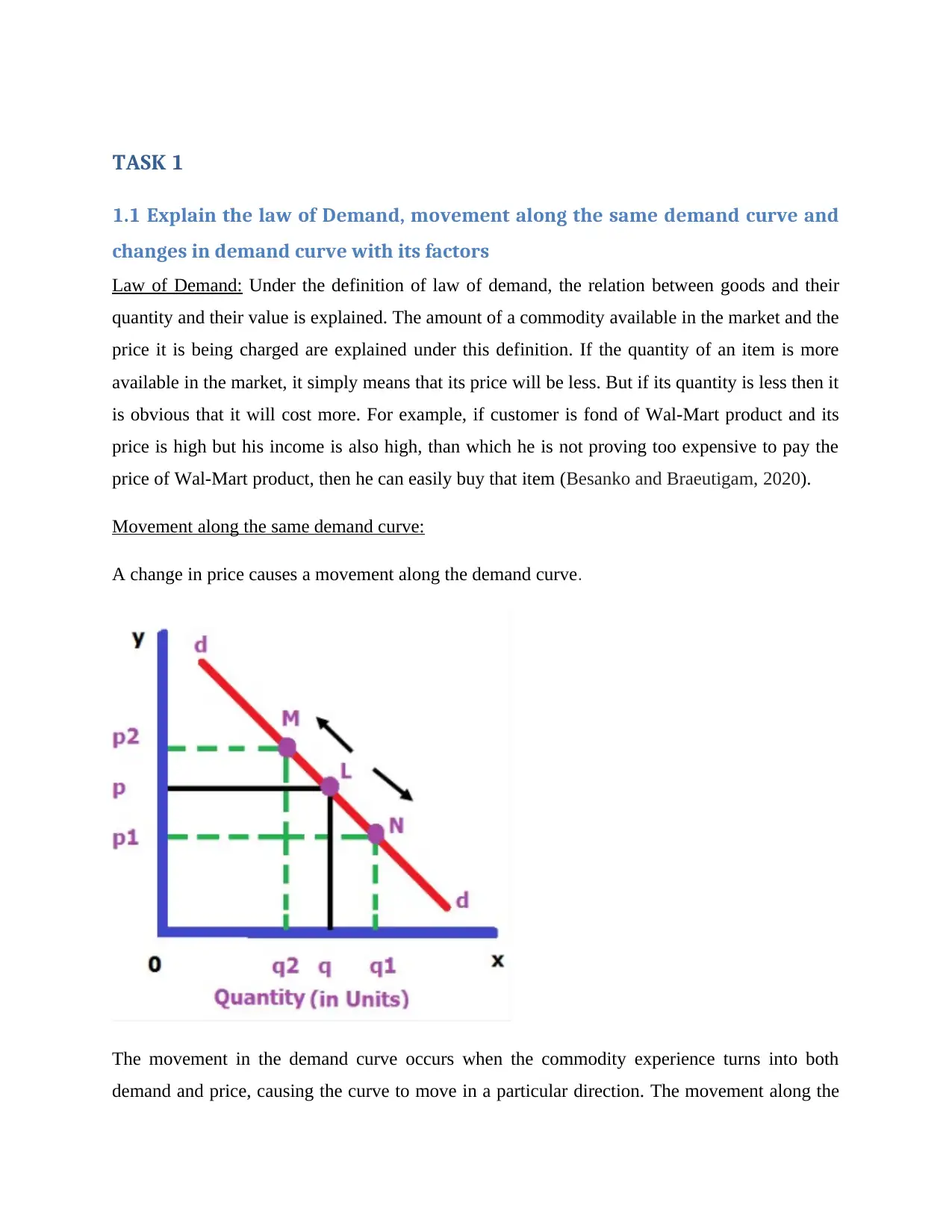
TASK 1
1.1 Explain the law of Demand, movement along the same demand curve and
changes in demand curve with its factors
Law of Demand: Under the definition of law of demand, the relation between goods and their
quantity and their value is explained. The amount of a commodity available in the market and the
price it is being charged are explained under this definition. If the quantity of an item is more
available in the market, it simply means that its price will be less. But if its quantity is less then it
is obvious that it will cost more. For example, if customer is fond of Wal-Mart product and its
price is high but his income is also high, than which he is not proving too expensive to pay the
price of Wal-Mart product, then he can easily buy that item (Besanko and Braeutigam, 2020).
Movement along the same demand curve:
A change in price causes a movement along the demand curve.
The movement in the demand curve occurs when the commodity experience turns into both
demand and price, causing the curve to move in a particular direction. The movement along the
1.1 Explain the law of Demand, movement along the same demand curve and
changes in demand curve with its factors
Law of Demand: Under the definition of law of demand, the relation between goods and their
quantity and their value is explained. The amount of a commodity available in the market and the
price it is being charged are explained under this definition. If the quantity of an item is more
available in the market, it simply means that its price will be less. But if its quantity is less then it
is obvious that it will cost more. For example, if customer is fond of Wal-Mart product and its
price is high but his income is also high, than which he is not proving too expensive to pay the
price of Wal-Mart product, then he can easily buy that item (Besanko and Braeutigam, 2020).
Movement along the same demand curve:
A change in price causes a movement along the demand curve.
The movement in the demand curve occurs when the commodity experience turns into both
demand and price, causing the curve to move in a particular direction. The movement along the
Secure Best Marks with AI Grader
Need help grading? Try our AI Grader for instant feedback on your assignments.
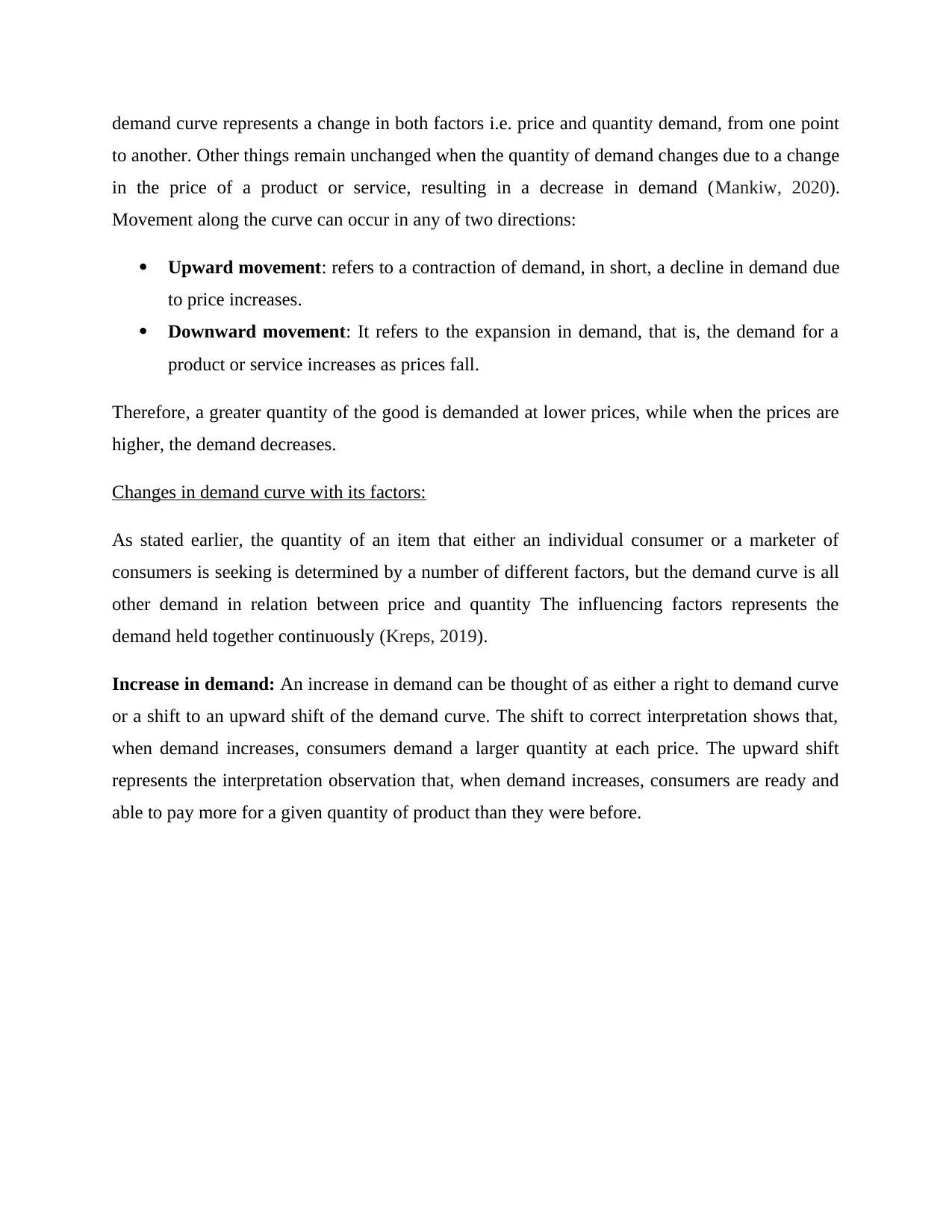
demand curve represents a change in both factors i.e. price and quantity demand, from one point
to another. Other things remain unchanged when the quantity of demand changes due to a change
in the price of a product or service, resulting in a decrease in demand (Mankiw, 2020).
Movement along the curve can occur in any of two directions:
Upward movement: refers to a contraction of demand, in short, a decline in demand due
to price increases.
Downward movement: It refers to the expansion in demand, that is, the demand for a
product or service increases as prices fall.
Therefore, a greater quantity of the good is demanded at lower prices, while when the prices are
higher, the demand decreases.
Changes in demand curve with its factors:
As stated earlier, the quantity of an item that either an individual consumer or a marketer of
consumers is seeking is determined by a number of different factors, but the demand curve is all
other demand in relation between price and quantity The influencing factors represents the
demand held together continuously (Kreps, 2019).
Increase in demand: An increase in demand can be thought of as either a right to demand curve
or a shift to an upward shift of the demand curve. The shift to correct interpretation shows that,
when demand increases, consumers demand a larger quantity at each price. The upward shift
represents the interpretation observation that, when demand increases, consumers are ready and
able to pay more for a given quantity of product than they were before.
to another. Other things remain unchanged when the quantity of demand changes due to a change
in the price of a product or service, resulting in a decrease in demand (Mankiw, 2020).
Movement along the curve can occur in any of two directions:
Upward movement: refers to a contraction of demand, in short, a decline in demand due
to price increases.
Downward movement: It refers to the expansion in demand, that is, the demand for a
product or service increases as prices fall.
Therefore, a greater quantity of the good is demanded at lower prices, while when the prices are
higher, the demand decreases.
Changes in demand curve with its factors:
As stated earlier, the quantity of an item that either an individual consumer or a marketer of
consumers is seeking is determined by a number of different factors, but the demand curve is all
other demand in relation between price and quantity The influencing factors represents the
demand held together continuously (Kreps, 2019).
Increase in demand: An increase in demand can be thought of as either a right to demand curve
or a shift to an upward shift of the demand curve. The shift to correct interpretation shows that,
when demand increases, consumers demand a larger quantity at each price. The upward shift
represents the interpretation observation that, when demand increases, consumers are ready and
able to pay more for a given quantity of product than they were before.
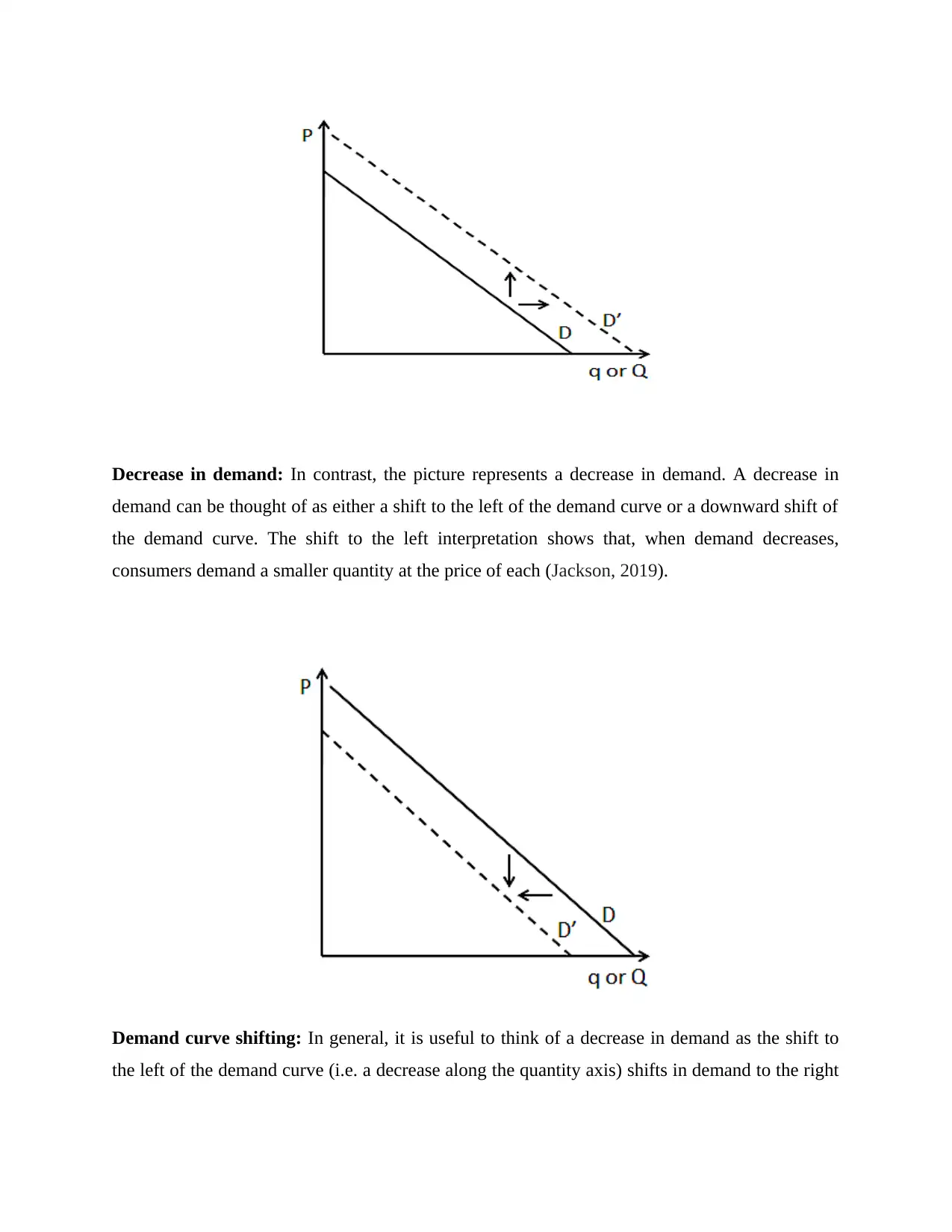
Decrease in demand: In contrast, the picture represents a decrease in demand. A decrease in
demand can be thought of as either a shift to the left of the demand curve or a downward shift of
the demand curve. The shift to the left interpretation shows that, when demand decreases,
consumers demand a smaller quantity at the price of each (Jackson, 2019).
Demand curve shifting: In general, it is useful to think of a decrease in demand as the shift to
the left of the demand curve (i.e. a decrease along the quantity axis) shifts in demand to the right
demand can be thought of as either a shift to the left of the demand curve or a downward shift of
the demand curve. The shift to the left interpretation shows that, when demand decreases,
consumers demand a smaller quantity at the price of each (Jackson, 2019).
Demand curve shifting: In general, it is useful to think of a decrease in demand as the shift to
the left of the demand curve (i.e. a decrease along the quantity axis) shifts in demand to the right
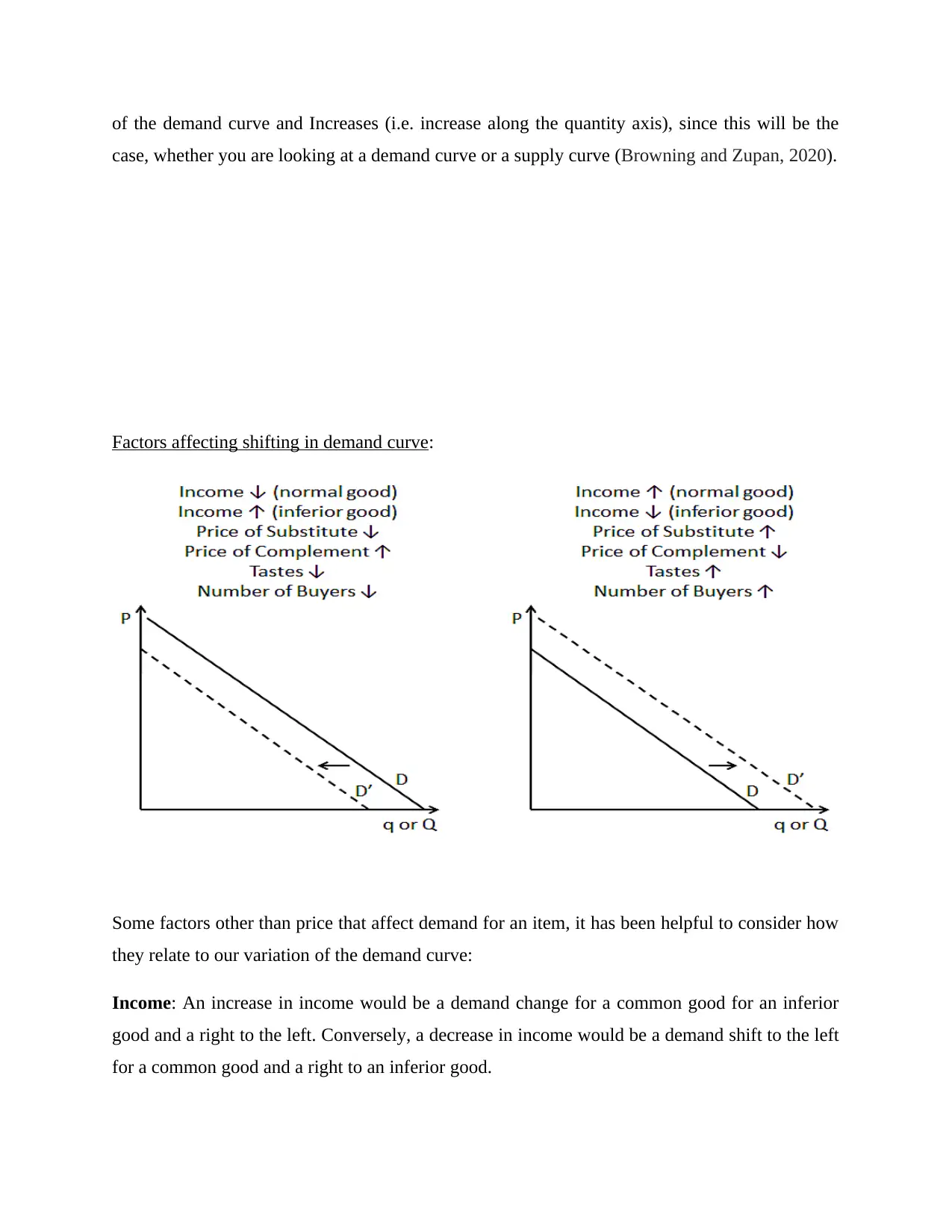
of the demand curve and Increases (i.e. increase along the quantity axis), since this will be the
case, whether you are looking at a demand curve or a supply curve (Browning and Zupan, 2020).
Factors affecting shifting in demand curve:
Some factors other than price that affect demand for an item, it has been helpful to consider how
they relate to our variation of the demand curve:
Income: An increase in income would be a demand change for a common good for an inferior
good and a right to the left. Conversely, a decrease in income would be a demand shift to the left
for a common good and a right to an inferior good.
case, whether you are looking at a demand curve or a supply curve (Browning and Zupan, 2020).
Factors affecting shifting in demand curve:
Some factors other than price that affect demand for an item, it has been helpful to consider how
they relate to our variation of the demand curve:
Income: An increase in income would be a demand change for a common good for an inferior
good and a right to the left. Conversely, a decrease in income would be a demand shift to the left
for a common good and a right to an inferior good.
Paraphrase This Document
Need a fresh take? Get an instant paraphrase of this document with our AI Paraphraser
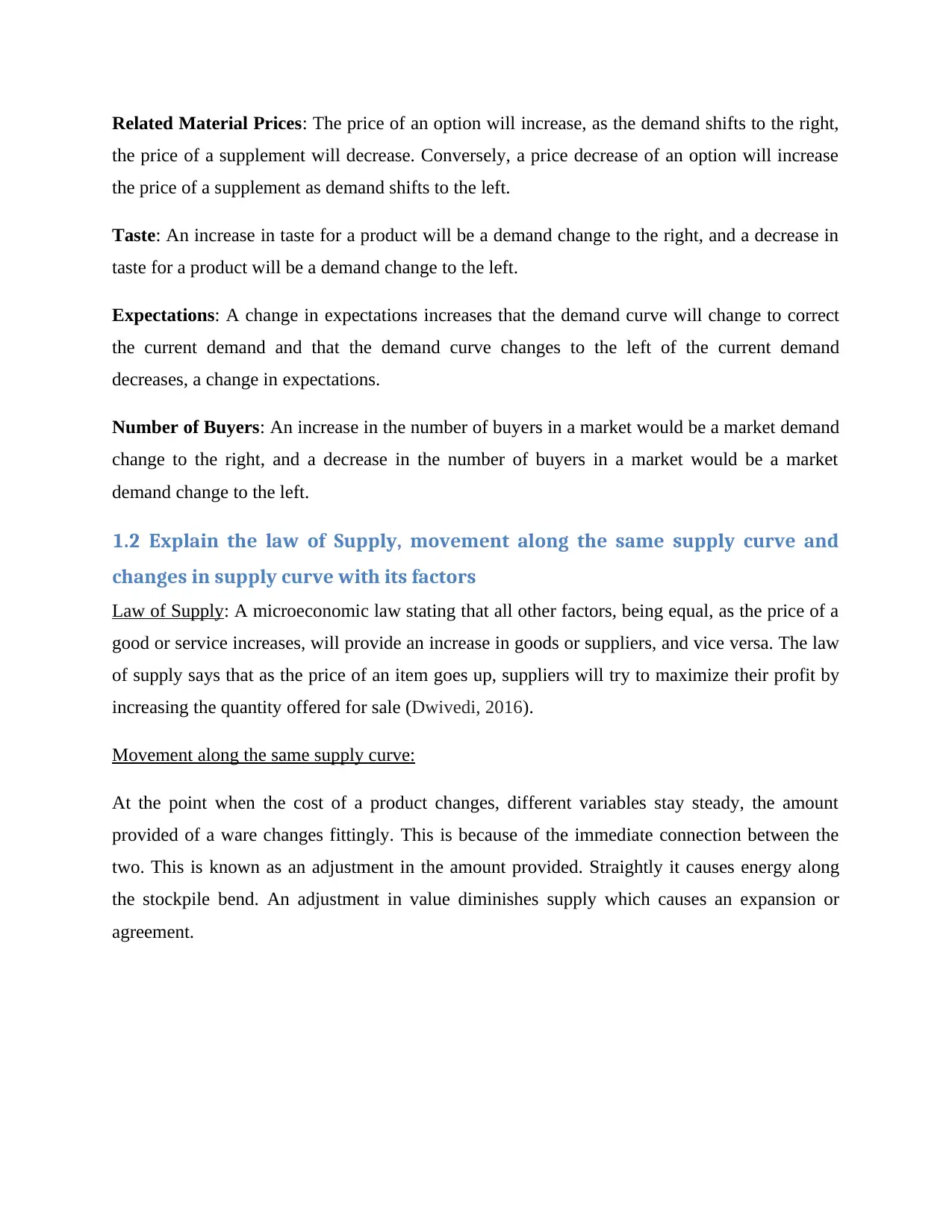
Related Material Prices: The price of an option will increase, as the demand shifts to the right,
the price of a supplement will decrease. Conversely, a price decrease of an option will increase
the price of a supplement as demand shifts to the left.
Taste: An increase in taste for a product will be a demand change to the right, and a decrease in
taste for a product will be a demand change to the left.
Expectations: A change in expectations increases that the demand curve will change to correct
the current demand and that the demand curve changes to the left of the current demand
decreases, a change in expectations.
Number of Buyers: An increase in the number of buyers in a market would be a market demand
change to the right, and a decrease in the number of buyers in a market would be a market
demand change to the left.
1.2 Explain the law of Supply, movement along the same supply curve and
changes in supply curve with its factors
Law of Supply: A microeconomic law stating that all other factors, being equal, as the price of a
good or service increases, will provide an increase in goods or suppliers, and vice versa. The law
of supply says that as the price of an item goes up, suppliers will try to maximize their profit by
increasing the quantity offered for sale (Dwivedi, 2016).
Movement along the same supply curve:
At the point when the cost of a product changes, different variables stay steady, the amount
provided of a ware changes fittingly. This is because of the immediate connection between the
two. This is known as an adjustment in the amount provided. Straightly it causes energy along
the stockpile bend. An adjustment in value diminishes supply which causes an expansion or
agreement.
the price of a supplement will decrease. Conversely, a price decrease of an option will increase
the price of a supplement as demand shifts to the left.
Taste: An increase in taste for a product will be a demand change to the right, and a decrease in
taste for a product will be a demand change to the left.
Expectations: A change in expectations increases that the demand curve will change to correct
the current demand and that the demand curve changes to the left of the current demand
decreases, a change in expectations.
Number of Buyers: An increase in the number of buyers in a market would be a market demand
change to the right, and a decrease in the number of buyers in a market would be a market
demand change to the left.
1.2 Explain the law of Supply, movement along the same supply curve and
changes in supply curve with its factors
Law of Supply: A microeconomic law stating that all other factors, being equal, as the price of a
good or service increases, will provide an increase in goods or suppliers, and vice versa. The law
of supply says that as the price of an item goes up, suppliers will try to maximize their profit by
increasing the quantity offered for sale (Dwivedi, 2016).
Movement along the same supply curve:
At the point when the cost of a product changes, different variables stay steady, the amount
provided of a ware changes fittingly. This is because of the immediate connection between the
two. This is known as an adjustment in the amount provided. Straightly it causes energy along
the stockpile bend. An adjustment in value diminishes supply which causes an expansion or
agreement.

On the off chance that costs rise, at that point different variables stay consistent; an increment in
the amount provided is called a development of supply. Directly, it is spoken to as an upward
movement along a similar inventory bend.
Then again, if costs fall, Wal-Mart decreases their stock, keeping different elements steady. This
is called constriction of the offer. Directly, it is spoken to as a descending movement with a
uniform stock bend.
Changes in supply curve with its factors
Increase in supply: When the value of the object itself remains unchanged but due to change in
any of the other components, only the supply changes, it is called an increase in supply. In this,
the position of the supply curve changes and it shifts to the right.
Decrease in supply: When the value of the item itself remains unchanged but due to change in
some of its other components, the quantity available for its supply is reduced, such a situation is
the amount provided is called a development of supply. Directly, it is spoken to as an upward
movement along a similar inventory bend.
Then again, if costs fall, Wal-Mart decreases their stock, keeping different elements steady. This
is called constriction of the offer. Directly, it is spoken to as a descending movement with a
uniform stock bend.
Changes in supply curve with its factors
Increase in supply: When the value of the object itself remains unchanged but due to change in
any of the other components, only the supply changes, it is called an increase in supply. In this,
the position of the supply curve changes and it shifts to the right.
Decrease in supply: When the value of the item itself remains unchanged but due to change in
some of its other components, the quantity available for its supply is reduced, such a situation is

called reduction in supply. This causes the supply curve to shift to the left (Karl, and et.al.,
2019).
Factors affecting change in supply:
1. Price of Goods: This component is the most important. When the price of a commodity
increases, its quantity of selling also increases and as the price decreases, its quantity also
declines. Changes in it result in contraction or expansion of supply.
2. Price of related goods: A certain item has two kinds of related items; optional item and
complementary item. An optional object is one that can be used in place of a main object; such
as Wal-Mart and D-Mart products can be used in place of each other. If the prices of alternative
goods rise, then the seller increases the production of alternative goods so that he can reduce
more money. Therefore, the main item type is affected by the price of the related item.
3. Modern technology: If a producer has modern production technology, he can produce more
in less time and with less cost. Hence more profit can be reduced. It also affects the production of
goods and availability in the market.
4. Price of raw material: If the price of the raw material to be produced increases, then the
seller will get less profit. This will reduce the seller's production and will incur this cost in the
production of high-profit items.
TASK 2
Compare and contrast emerging theories and models in 21st century
contemporary economics with those of the 20th century, and relate both of
these to modern business practices.
Contemporary economics also known as Neoliberalism is generally associated with policies such
as cutting trade rates and barriers. Its influence has liberalized the international movement of
capital, and limited the power of trade unions. It has disbanded state-owned enterprises, sold off
public assets and generally opened up our lives to domination, thinking the market.
2019).
Factors affecting change in supply:
1. Price of Goods: This component is the most important. When the price of a commodity
increases, its quantity of selling also increases and as the price decreases, its quantity also
declines. Changes in it result in contraction or expansion of supply.
2. Price of related goods: A certain item has two kinds of related items; optional item and
complementary item. An optional object is one that can be used in place of a main object; such
as Wal-Mart and D-Mart products can be used in place of each other. If the prices of alternative
goods rise, then the seller increases the production of alternative goods so that he can reduce
more money. Therefore, the main item type is affected by the price of the related item.
3. Modern technology: If a producer has modern production technology, he can produce more
in less time and with less cost. Hence more profit can be reduced. It also affects the production of
goods and availability in the market.
4. Price of raw material: If the price of the raw material to be produced increases, then the
seller will get less profit. This will reduce the seller's production and will incur this cost in the
production of high-profit items.
TASK 2
Compare and contrast emerging theories and models in 21st century
contemporary economics with those of the 20th century, and relate both of
these to modern business practices.
Contemporary economics also known as Neoliberalism is generally associated with policies such
as cutting trade rates and barriers. Its influence has liberalized the international movement of
capital, and limited the power of trade unions. It has disbanded state-owned enterprises, sold off
public assets and generally opened up our lives to domination, thinking the market.
Secure Best Marks with AI Grader
Need help grading? Try our AI Grader for instant feedback on your assignments.
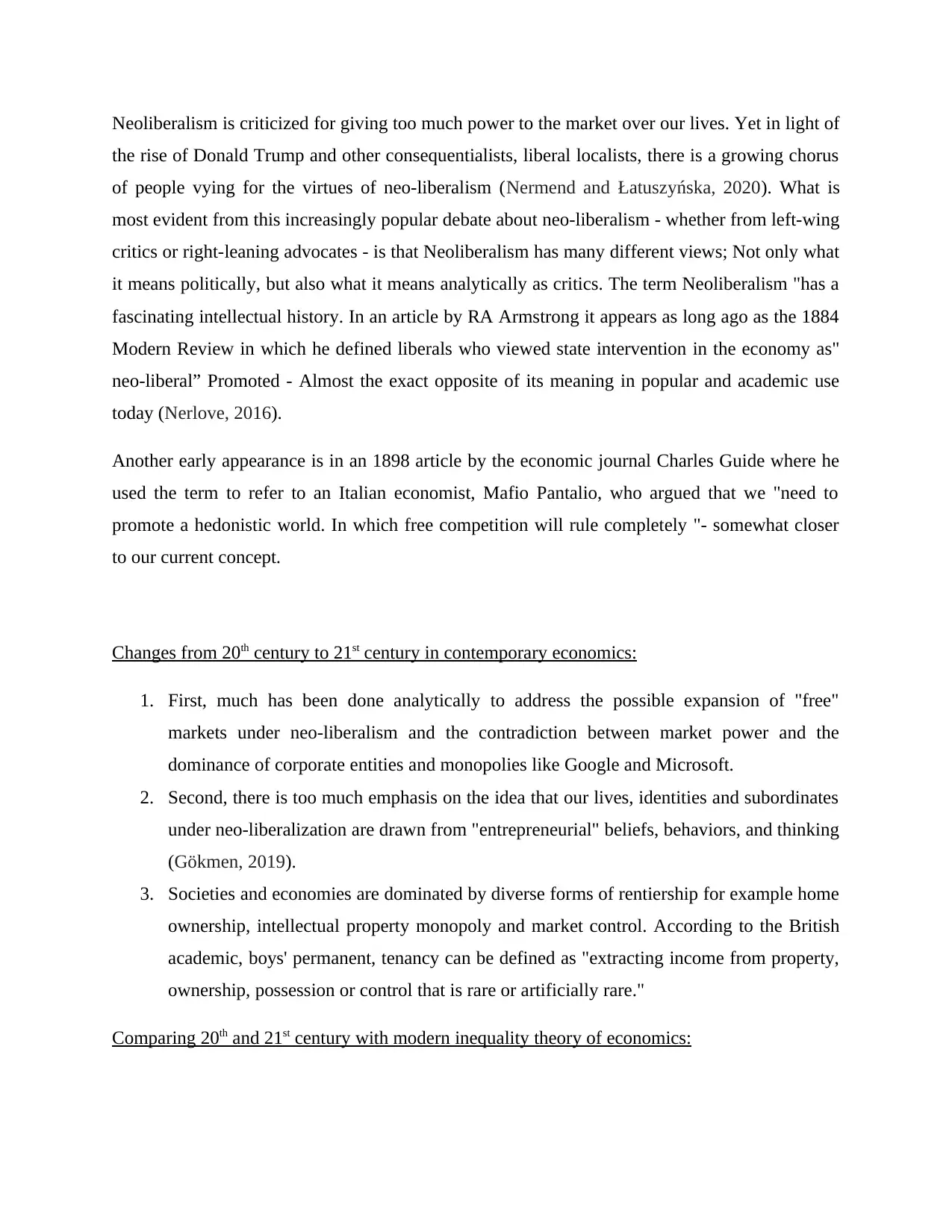
Neoliberalism is criticized for giving too much power to the market over our lives. Yet in light of
the rise of Donald Trump and other consequentialists, liberal localists, there is a growing chorus
of people vying for the virtues of neo-liberalism (Nermend and Łatuszyńska, 2020). What is
most evident from this increasingly popular debate about neo-liberalism - whether from left-wing
critics or right-leaning advocates - is that Neoliberalism has many different views; Not only what
it means politically, but also what it means analytically as critics. The term Neoliberalism "has a
fascinating intellectual history. In an article by RA Armstrong it appears as long ago as the 1884
Modern Review in which he defined liberals who viewed state intervention in the economy as"
neo-liberal” Promoted - Almost the exact opposite of its meaning in popular and academic use
today (Nerlove, 2016).
Another early appearance is in an 1898 article by the economic journal Charles Guide where he
used the term to refer to an Italian economist, Mafio Pantalio, who argued that we "need to
promote a hedonistic world. In which free competition will rule completely "- somewhat closer
to our current concept.
Changes from 20th century to 21st century in contemporary economics:
1. First, much has been done analytically to address the possible expansion of "free"
markets under neo-liberalism and the contradiction between market power and the
dominance of corporate entities and monopolies like Google and Microsoft.
2. Second, there is too much emphasis on the idea that our lives, identities and subordinates
under neo-liberalization are drawn from "entrepreneurial" beliefs, behaviors, and thinking
(Gökmen, 2019).
3. Societies and economies are dominated by diverse forms of rentiership for example home
ownership, intellectual property monopoly and market control. According to the British
academic, boys' permanent, tenancy can be defined as "extracting income from property,
ownership, possession or control that is rare or artificially rare."
Comparing 20th and 21st century with modern inequality theory of economics:
the rise of Donald Trump and other consequentialists, liberal localists, there is a growing chorus
of people vying for the virtues of neo-liberalism (Nermend and Łatuszyńska, 2020). What is
most evident from this increasingly popular debate about neo-liberalism - whether from left-wing
critics or right-leaning advocates - is that Neoliberalism has many different views; Not only what
it means politically, but also what it means analytically as critics. The term Neoliberalism "has a
fascinating intellectual history. In an article by RA Armstrong it appears as long ago as the 1884
Modern Review in which he defined liberals who viewed state intervention in the economy as"
neo-liberal” Promoted - Almost the exact opposite of its meaning in popular and academic use
today (Nerlove, 2016).
Another early appearance is in an 1898 article by the economic journal Charles Guide where he
used the term to refer to an Italian economist, Mafio Pantalio, who argued that we "need to
promote a hedonistic world. In which free competition will rule completely "- somewhat closer
to our current concept.
Changes from 20th century to 21st century in contemporary economics:
1. First, much has been done analytically to address the possible expansion of "free"
markets under neo-liberalism and the contradiction between market power and the
dominance of corporate entities and monopolies like Google and Microsoft.
2. Second, there is too much emphasis on the idea that our lives, identities and subordinates
under neo-liberalization are drawn from "entrepreneurial" beliefs, behaviors, and thinking
(Gökmen, 2019).
3. Societies and economies are dominated by diverse forms of rentiership for example home
ownership, intellectual property monopoly and market control. According to the British
academic, boys' permanent, tenancy can be defined as "extracting income from property,
ownership, possession or control that is rare or artificially rare."
Comparing 20th and 21st century with modern inequality theory of economics:
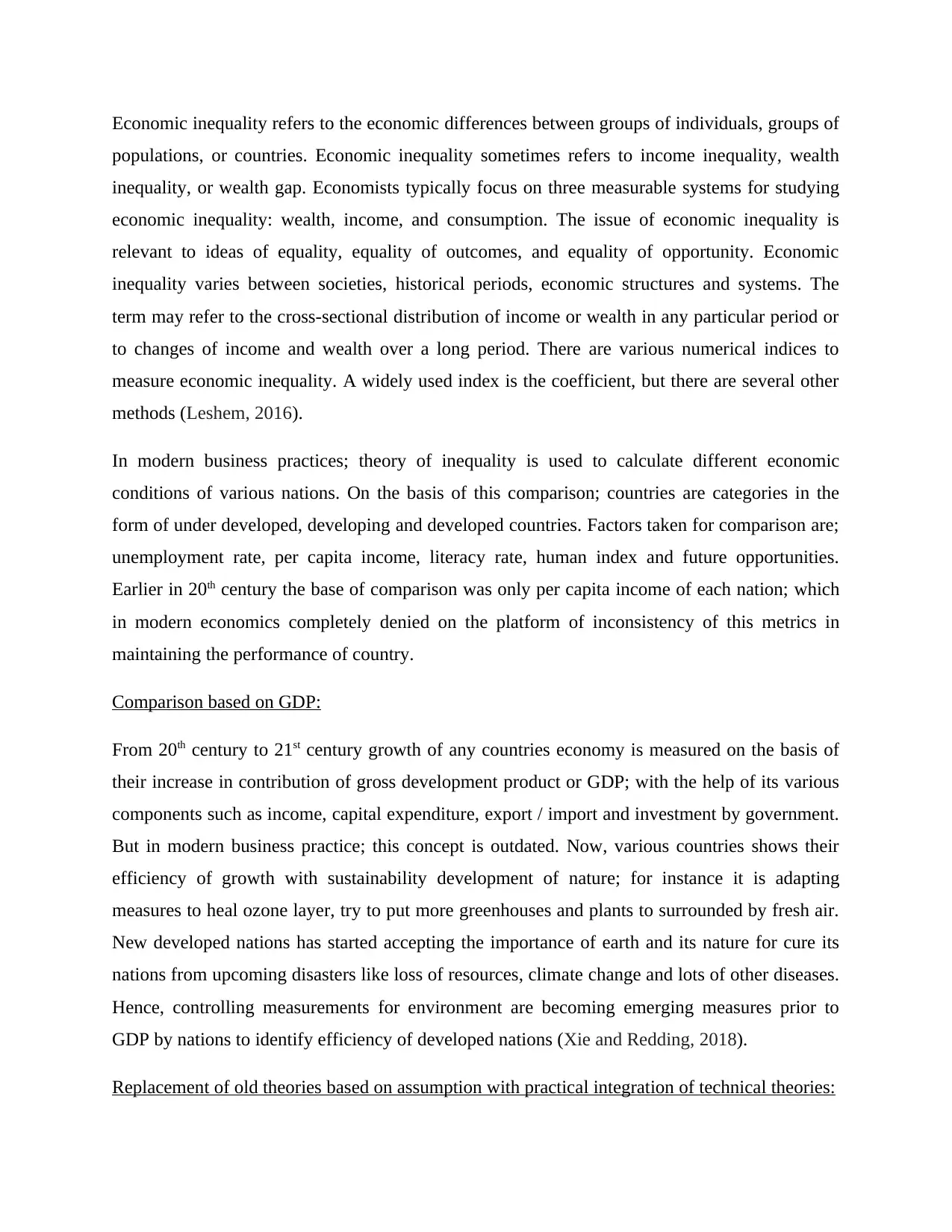
Economic inequality refers to the economic differences between groups of individuals, groups of
populations, or countries. Economic inequality sometimes refers to income inequality, wealth
inequality, or wealth gap. Economists typically focus on three measurable systems for studying
economic inequality: wealth, income, and consumption. The issue of economic inequality is
relevant to ideas of equality, equality of outcomes, and equality of opportunity. Economic
inequality varies between societies, historical periods, economic structures and systems. The
term may refer to the cross-sectional distribution of income or wealth in any particular period or
to changes of income and wealth over a long period. There are various numerical indices to
measure economic inequality. A widely used index is the coefficient, but there are several other
methods (Leshem, 2016).
In modern business practices; theory of inequality is used to calculate different economic
conditions of various nations. On the basis of this comparison; countries are categories in the
form of under developed, developing and developed countries. Factors taken for comparison are;
unemployment rate, per capita income, literacy rate, human index and future opportunities.
Earlier in 20th century the base of comparison was only per capita income of each nation; which
in modern economics completely denied on the platform of inconsistency of this metrics in
maintaining the performance of country.
Comparison based on GDP:
From 20th century to 21st century growth of any countries economy is measured on the basis of
their increase in contribution of gross development product or GDP; with the help of its various
components such as income, capital expenditure, export / import and investment by government.
But in modern business practice; this concept is outdated. Now, various countries shows their
efficiency of growth with sustainability development of nature; for instance it is adapting
measures to heal ozone layer, try to put more greenhouses and plants to surrounded by fresh air.
New developed nations has started accepting the importance of earth and its nature for cure its
nations from upcoming disasters like loss of resources, climate change and lots of other diseases.
Hence, controlling measurements for environment are becoming emerging measures prior to
GDP by nations to identify efficiency of developed nations (Xie and Redding, 2018).
Replacement of old theories based on assumption with practical integration of technical theories:
populations, or countries. Economic inequality sometimes refers to income inequality, wealth
inequality, or wealth gap. Economists typically focus on three measurable systems for studying
economic inequality: wealth, income, and consumption. The issue of economic inequality is
relevant to ideas of equality, equality of outcomes, and equality of opportunity. Economic
inequality varies between societies, historical periods, economic structures and systems. The
term may refer to the cross-sectional distribution of income or wealth in any particular period or
to changes of income and wealth over a long period. There are various numerical indices to
measure economic inequality. A widely used index is the coefficient, but there are several other
methods (Leshem, 2016).
In modern business practices; theory of inequality is used to calculate different economic
conditions of various nations. On the basis of this comparison; countries are categories in the
form of under developed, developing and developed countries. Factors taken for comparison are;
unemployment rate, per capita income, literacy rate, human index and future opportunities.
Earlier in 20th century the base of comparison was only per capita income of each nation; which
in modern economics completely denied on the platform of inconsistency of this metrics in
maintaining the performance of country.
Comparison based on GDP:
From 20th century to 21st century growth of any countries economy is measured on the basis of
their increase in contribution of gross development product or GDP; with the help of its various
components such as income, capital expenditure, export / import and investment by government.
But in modern business practice; this concept is outdated. Now, various countries shows their
efficiency of growth with sustainability development of nature; for instance it is adapting
measures to heal ozone layer, try to put more greenhouses and plants to surrounded by fresh air.
New developed nations has started accepting the importance of earth and its nature for cure its
nations from upcoming disasters like loss of resources, climate change and lots of other diseases.
Hence, controlling measurements for environment are becoming emerging measures prior to
GDP by nations to identify efficiency of developed nations (Xie and Redding, 2018).
Replacement of old theories based on assumption with practical integration of technical theories:
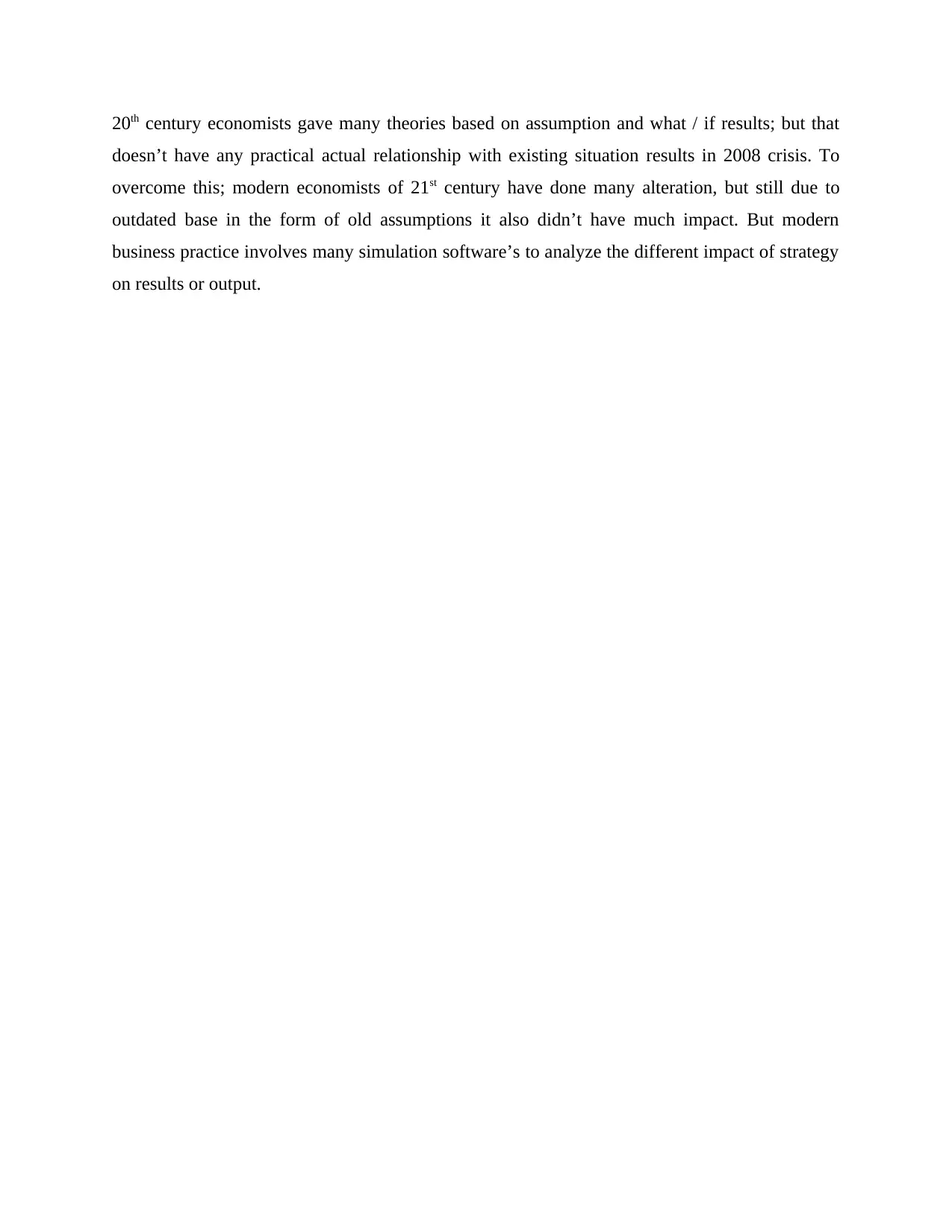
20th century economists gave many theories based on assumption and what / if results; but that
doesn’t have any practical actual relationship with existing situation results in 2008 crisis. To
overcome this; modern economists of 21st century have done many alteration, but still due to
outdated base in the form of old assumptions it also didn’t have much impact. But modern
business practice involves many simulation software’s to analyze the different impact of strategy
on results or output.
doesn’t have any practical actual relationship with existing situation results in 2008 crisis. To
overcome this; modern economists of 21st century have done many alteration, but still due to
outdated base in the form of old assumptions it also didn’t have much impact. But modern
business practice involves many simulation software’s to analyze the different impact of strategy
on results or output.
Paraphrase This Document
Need a fresh take? Get an instant paraphrase of this document with our AI Paraphraser
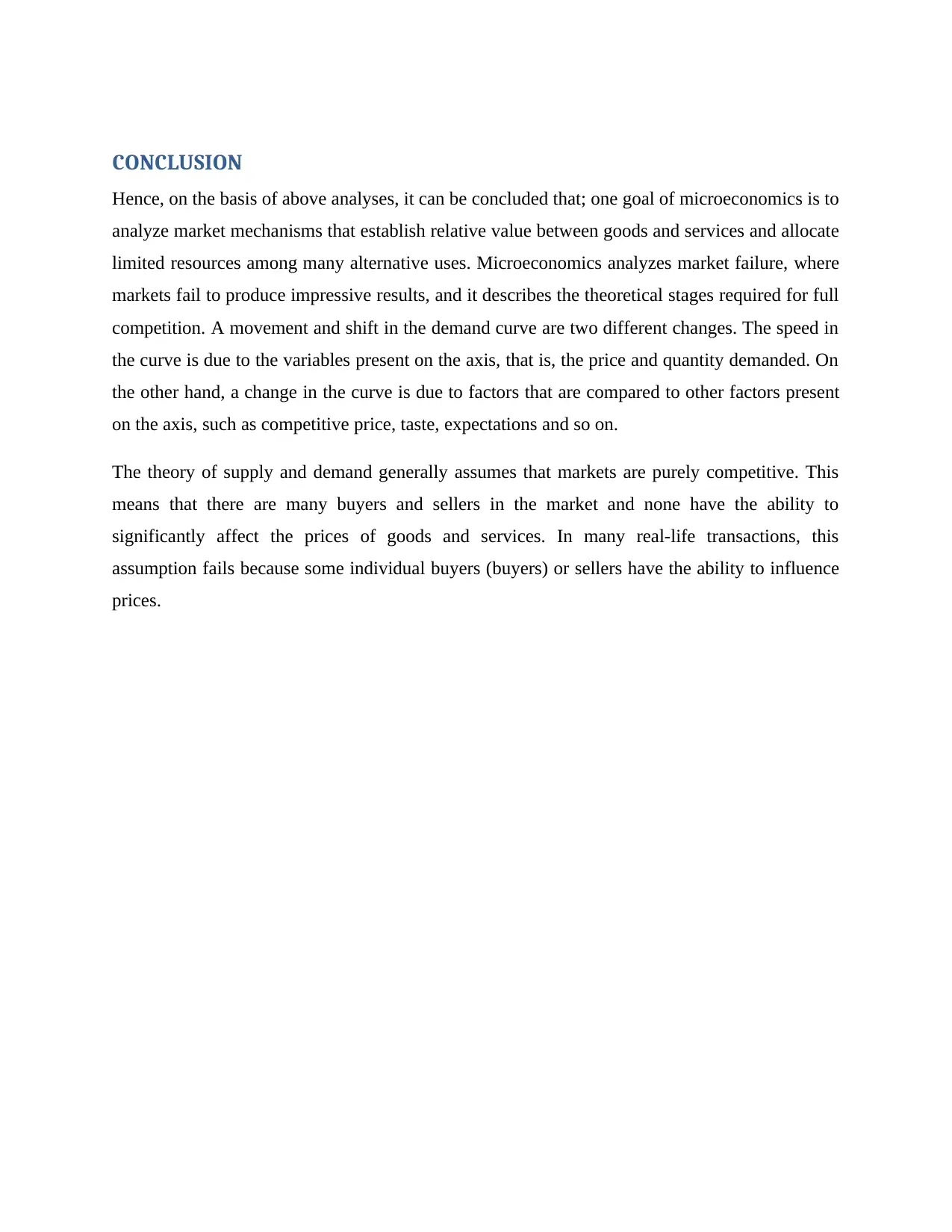
CONCLUSION
Hence, on the basis of above analyses, it can be concluded that; one goal of microeconomics is to
analyze market mechanisms that establish relative value between goods and services and allocate
limited resources among many alternative uses. Microeconomics analyzes market failure, where
markets fail to produce impressive results, and it describes the theoretical stages required for full
competition. A movement and shift in the demand curve are two different changes. The speed in
the curve is due to the variables present on the axis, that is, the price and quantity demanded. On
the other hand, a change in the curve is due to factors that are compared to other factors present
on the axis, such as competitive price, taste, expectations and so on.
The theory of supply and demand generally assumes that markets are purely competitive. This
means that there are many buyers and sellers in the market and none have the ability to
significantly affect the prices of goods and services. In many real-life transactions, this
assumption fails because some individual buyers (buyers) or sellers have the ability to influence
prices.
Hence, on the basis of above analyses, it can be concluded that; one goal of microeconomics is to
analyze market mechanisms that establish relative value between goods and services and allocate
limited resources among many alternative uses. Microeconomics analyzes market failure, where
markets fail to produce impressive results, and it describes the theoretical stages required for full
competition. A movement and shift in the demand curve are two different changes. The speed in
the curve is due to the variables present on the axis, that is, the price and quantity demanded. On
the other hand, a change in the curve is due to factors that are compared to other factors present
on the axis, such as competitive price, taste, expectations and so on.
The theory of supply and demand generally assumes that markets are purely competitive. This
means that there are many buyers and sellers in the market and none have the ability to
significantly affect the prices of goods and services. In many real-life transactions, this
assumption fails because some individual buyers (buyers) or sellers have the ability to influence
prices.

REFERENCES
Books and Journals
Besanko, D. and Braeutigam, R., 2020. Microeconomics. John Wiley & Sons.
Browning, E.K. and Zupan, M.A., 2020. Microeconomics: Theory and Applications. John Wiley
& Sons.
Dwivedi, D.N., 2016. Microeconomics: Theory and Applications. Vikas Publishing House.
Gökmen, A., 2019. Intercultural Negotiations in Global Business: A Contemporary and
Comprehensive Literature Review. International Journal of Sustainable Economies
Management (IJSEM), 8(2), pp.1-9.
Jackson, D.H., 2019. The microeconomics of the timber industry. Routledge.
Karl, E., CASE, F., OSTER, R. and SHARON, E., 2019. PRINCIPLES OF
MICROECONOMICS. PEARSON.
Kreps, D.M., 2019. Microeconomics for managers. Princeton University Press.
Leshem, D., 2016. Retrospectives: What did the ancient Greeks mean by Oikonomia?. Journal of
Economic Perspectives, 30(1), pp.225-38.
Mankiw, N.G., 2020. Principles of microeconomics. Cengage Learning.
Nerlove, M. ed., 2016. Issues in Contemporary Economics: Volume 2: Macroeconomics and
Econometrics. Springer.
Nermend, K. and Łatuszyńska, M., 2020. Experimental and Quantitative Methods in
Contemporary Economics. Springer.
Xie, E. and Redding, K.S., 2018. State-owned enterprises in the contemporary global business
scenario: introduction. International Journal of Public Sector Management.
Books and Journals
Besanko, D. and Braeutigam, R., 2020. Microeconomics. John Wiley & Sons.
Browning, E.K. and Zupan, M.A., 2020. Microeconomics: Theory and Applications. John Wiley
& Sons.
Dwivedi, D.N., 2016. Microeconomics: Theory and Applications. Vikas Publishing House.
Gökmen, A., 2019. Intercultural Negotiations in Global Business: A Contemporary and
Comprehensive Literature Review. International Journal of Sustainable Economies
Management (IJSEM), 8(2), pp.1-9.
Jackson, D.H., 2019. The microeconomics of the timber industry. Routledge.
Karl, E., CASE, F., OSTER, R. and SHARON, E., 2019. PRINCIPLES OF
MICROECONOMICS. PEARSON.
Kreps, D.M., 2019. Microeconomics for managers. Princeton University Press.
Leshem, D., 2016. Retrospectives: What did the ancient Greeks mean by Oikonomia?. Journal of
Economic Perspectives, 30(1), pp.225-38.
Mankiw, N.G., 2020. Principles of microeconomics. Cengage Learning.
Nerlove, M. ed., 2016. Issues in Contemporary Economics: Volume 2: Macroeconomics and
Econometrics. Springer.
Nermend, K. and Łatuszyńska, M., 2020. Experimental and Quantitative Methods in
Contemporary Economics. Springer.
Xie, E. and Redding, K.S., 2018. State-owned enterprises in the contemporary global business
scenario: introduction. International Journal of Public Sector Management.
1 out of 15
Related Documents
Your All-in-One AI-Powered Toolkit for Academic Success.
+13062052269
info@desklib.com
Available 24*7 on WhatsApp / Email
![[object Object]](/_next/static/media/star-bottom.7253800d.svg)
Unlock your academic potential
© 2024 | Zucol Services PVT LTD | All rights reserved.





